Tax Updates Early May
IRS Updates May 2023 by Paul Davis
Better Late Than Later
The IRS is urging taxpayers who missed the April 18 tax-filing deadline to file as soon as possible. Those who owe taxes should file quickly to minimize penalties and interest, which can accrue over time. For those who should receive a refund, there is no late-filing penalty. Some taxpayers automatically qualify for extra time to file and pay, including disaster victims, military members serving in a combat zone and support personnel, and taxpayers outside the United States. There are options for taxpayers struggling to pay their tax bill.
May 15 Deadline for Tax-Exempt
The IRS reminds tax-exempt organizations that their filing deadline is May 15, 2023. Those operating on a calendar-year basis must file a return by this date. Form 990-series (information returns such as Form 990, 990-EZ, 990-PF), Forms 990-N, 990-T, and Form 4720 must be e-filed. Those requiring additional time to file beyond the May 15 deadline can request a six-month automatic extension, however this does not extend the time for paying any taxes due. Online Workshops are also available to help exempt organizations comply with their filing requirements.
Tax Relief for Indiana Victims
Storm victims in Indiana now have until July 31, 2023, to file various federal individual and business tax returns and make tax payments. This relief applies to any area designated by the Federal Emergency Management Agency (FEMA) as a result of tornadoes, severe storms, and wind that occurred on March 31 and April 1. Taxpayers and businesses in Allen, Benton, Clinton, Grant, Howard, Johnson, Lake, Monroe, Morgan, Owen, Sullivan, and White counties qualify, in addition to any other areas later designated. This relief is automatic, and there is no need to contact the IRS unless an affected taxpayer incorrectly receives a late filing or late payment penalty notice. As always, an updated list of eligible localities is available.
Put Withholding Estimator to Work
The IRS suggests taxpayers get a head start on the 2024 filing season by using the Tax Withholding Estimator to help update the amount of tax to have taken out of their 2023 pay. It is especially useful after a major life change such as marriage, divorce, birth or adoption of a child, a home purchase, or a significant change in income. Those who received a large refund or owed a lot of tax this year would also benefit from using the estimator. To receive the most accurate estimate, have on hand recent pay statements (for both spouses if married), other income sources, and the most recent income tax return.

